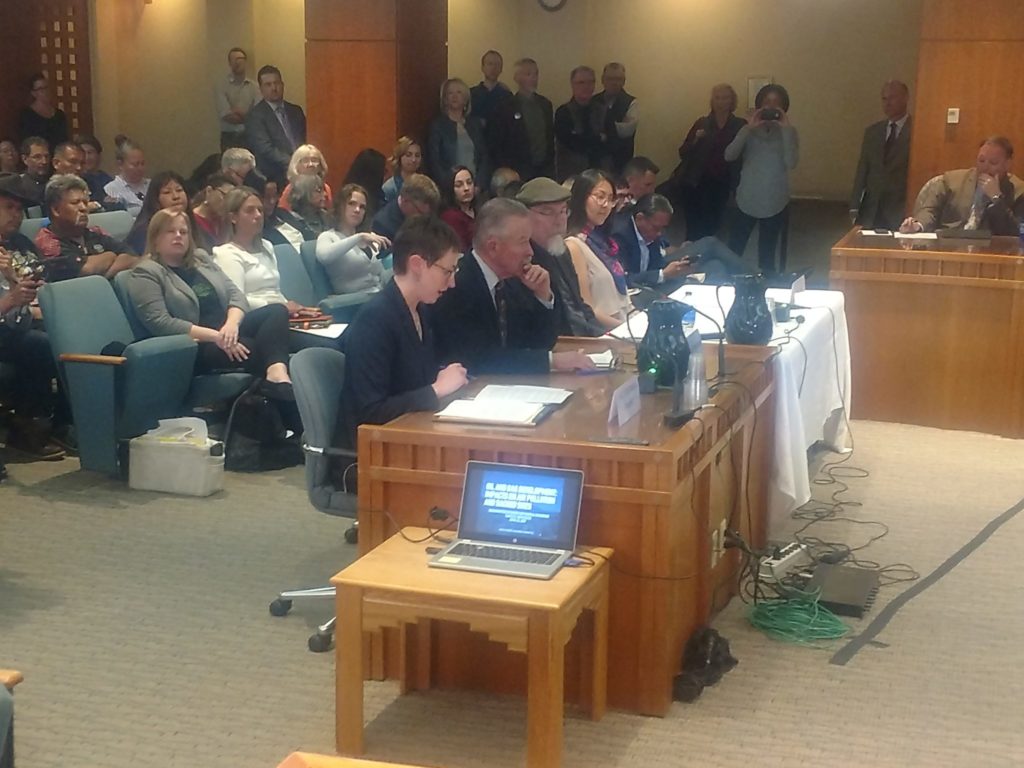- Home
- >
- Press Releases/Announcements
- >
- Reed Testifies on Chaco at House Committee Field H...
Santa Fe, NM (April 15, 2019)—Archaeology Southwest Preservation Archaeologist and Chaco Scholar Paul F. Reed testified before a delegation of congressional representatives at a field hearing in Santa Fe, New Mexico, this morning.
The delegation included Representative Raul Grijalva (D-AZ), Chair of the House Committee on Natural Resources; Representative Alan Lowenthal (D-CA), Chair of the Subcommittee on Energy and Mineral Resources, who presided over the hearing; Representative Deb Haaland (D-NM); and Representative Ben Ray Luján (D-NM), Assistant Speaker of the U.S. House, who had requested the subcommittee hearing.
Four panels of experts testified regarding “Oil and Gas Development: Impacts on Air Pollution and Sacred Sites.” The first was Governor Michelle Lujan Grisham of New Mexico. The second panel comprised Governor Brian Vallo (Pueblo of Acoma); Governor J. Michael Chavarria (Santa Clara Pueblo); Vice President Myron Lizer (Navajo Nation); and Rickie Nez, Chair of the Resources and Development Committee, Navajo Nation Council.

Reed provided archaeological expert testimony as part of the third panel, underscoring the importance of the greater Chaco cultural landscape to Pueblo and Navajo peoples. His testimony included recommendations for public land management agencies, emphasizing the necessity of more robust consultation with tribes and the National Park Service.
“Many sites associated with ancient Chacoan society are protected within the boundaries of Chaco Culture National Historical Park. Chaco Canyon and several outlying great houses are UNESCO World Heritage Sites that preserve the history and culture of the Pueblo people. Furthermore, Chaco Canyon is the ancestral home of Pueblo people and it is where many of the cultural traditions that are practiced to this day at Acoma, Zuni, Tesuque, Zia, Hopi, Taos, and other pueblos in New Mexico emerged. Over more recent centuries, the landscape around Chaco was settled by the Navajo people and other groups who have added their own unique traditions to the rich cultural legacy.
“Despite the protection offered by Chaco Culture National Historical Park, many sites lie outside the Park across the Greater Chaco Landscape. These places, many of which are as significant as those within Park boundaries, are scarcely protected from the ravages of oil‐gas development. Unfortunately, these include components of the Chaco Culture World Heritage Site like Pierre’s Site, located on federal land managed by the Bureau of Land Management.
“Increased oil‐gas development associated with the Mancos‐Gallup Shale play in northwest New Mexico has been threatening fragile Chaco‐affiliated cultural resources across a large portion of the San Juan Basin since late 2011. The threat to sensitive cultural resources is heightened by several mid‐2017 executive and secretarial orders from the Trump administration that aim to prioritize energy development on public lands.
“In fact, over the past year-and‐a‐half, the administration has proposed leasing within a few miles of the Park no less than three times, only to defer at the last minute because of out‐cry from Tribes, the archaeological community, and many others. But these deferrals are temporary, and if fully implemented, these orders will further fragment and degrade the Greater Chaco Landscape.”
In his testimony, Reed also discussed the thinking behind the 10-mile buffer zone adjacent to Chaco Culture National Historical Park (NHP). The zone represents a longstanding yet nonbinding agreement to eschew oil-gas development on these lands.
“Widespread leasing and drilling has continued on immediately adjacent lands, which has resulted in significant visual and auditory impacts and fragmentation of the broader cultural landscape…
“Archaeology Southwest and its partners have advocated for a permanent exclusion of new oil‐gas leasing within a 10‐mile cultural protection zone around Chaco Park and its outlying units. We fully supported Senate Bill 2907 introduced in 2018 by Senators Udall and Heinrich that would provide for the withdrawal of Federal minerals in this 10‐mile cultural protection zone around Chaco Culture NHP. A 2019 version of this bill has just been introduced in the Senate along with a House companion bill, with Congressman Luján as lead sponsor.”
To learn more about the Chaco Cultural Heritage Protection Act, read this news release at Rep. Ben Ray Luján’s website.
To read Paul Reed’s written testimony in full, click here (opens as a PDF). To read more about the hearing and review testimonies of the other panelists, visit the subcommittee hearing page here.
Following the third panel’s testimony, Reed responded to questions by Representatives Lowenthal and Grijalva regarding cultural identity and what life would have looked like in Chaco’s heyday. Paul acknowledged that any view of ancient Chaco depends on deep tribal knowledge and archaeology. He painted a verbal picture of a dynamic community with babies crying, dogs barking, potters working, and other sights and sounds, all against the backdrop of large and impressive buildings.
“Looking toward Chaco Wash, which was more of a river then, you would have seen farmers working in fields of corn, beans, and squash,” Reed said.
About Archaeology Southwest and Protecting the Greater Chaco Landscape
During the last six years, Archaeology Southwest and its partners have cooperated with the Bureau of Land Management Farmington Field Office and Bureau of Indian Affairs as these agencies have been in the process of amending the 2003 Resource Management Plan for the Farmington Field Office and drafting new Environmental Impact Statements for their regions . Our partners include the All‐Pueblo Council of Governors, The Wilderness Society, the National Trust for Historic Preservation, National Parks Conservation Association, Friends of Cedar Mesa, New Mexico Wilderness Alliance, Conservation Lands Foundation, and Pew Charitable Trusts. Learn more at archaeologysouthwest.org/projects/oil-development-and-the-chaco-cultural-landscape/.
Archaeology Southwest is a private 501(c)(3) nonprofit organization based in Tucson, Arizona, that explores and protects the places of our past across the American Southwest and Mexican Northwest. For three decades, Archaeology Southwest has fostered meaningful connections to the past and respectfully safeguarded its irreplaceable resources. Learn more at archaeologysouthwest.org.
Explore the News
Media contact:
Paul F. Reed
preed@archaeologysouthwest.org
505-486-4107
Reed written testimony in full (opens as a PDF)